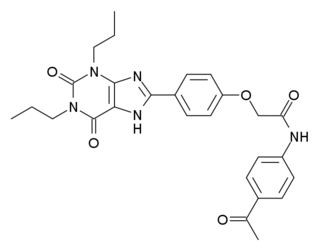GABAergic means "pertaining to or affecting the neurotransmitter GABA". A synapse is GABAergic if it uses GABA as its neurotransmitter. A GABAergic neuron produces GABA. A substance is GABAergic if it produces its effects via interactions with the GABA system, such as by stimulating or blocking neurotransmission.
Glutamatergic means "related to glutamate".

The adenosine A1 receptor is one member of the adenosine receptor group of G protein-coupled receptors with adenosine as endogenous ligand.

CGS-21680 is a specific adenosine A2A subtype receptor agonist. It is usually presented as an organic hydrochloride salt with a molecular weight of 536.0 g/M. It is soluble up to 3.4 mg/mL in DMSO and 20 mg/mL in 45% (w/v) aq 2-hydroxypropyl-β-cyclodextrin.

The adenosine A2A receptor, also known as ADORA2A, is an adenosine receptor, and also denotes the human gene encoding it.

The adenosine A3 receptor, also known as ADORA3, is an adenosine receptor, but also denotes the human gene encoding it.
Histaminergic means "working on the histamine system", and histaminic means "related to histamine".

The adenosine A2B receptor, also known as ADORA2B, is a G-protein coupled adenosine receptor, and also denotes the human adenosine A2b receptor gene which encodes it.

8-Cyclopentyl-1,3-dipropylxanthine (DPCPX, PD-116,948) is a drug which acts as a potent and selective antagonist for the adenosine A1 receptor. It has high selectivity for A1 over other adenosine receptor subtypes, but as with other xanthine derivatives DPCPX also acts as a phosphodiesterase inhibitor, and is almost as potent as rolipram at inhibiting PDE4. It has been used to study the function of the adenosine A1 receptor in animals, which has been found to be involved in several important functions such as regulation of breathing and activity in various regions of the brain, and DPCPX has also been shown to produce behavioural effects such as increasing the hallucinogen-appropriate responding produced by the 5-HT2A agonist DOI, and the dopamine release induced by MDMA, as well as having interactions with a range of anticonvulsant drugs.

SCH-58261 is a drug which acts as a potent and selective antagonist for the adenosine receptor A2A, with more than 50x selectivity for A2A over other adenosine receptors. It has been used to investigate the mechanism of action of caffeine, which is a mixed A1 / A2A antagonist, and has shown that the A2A receptor is primarily responsible for the stimulant effects of caffeine, but blockade of both A1 and A2A receptors is required to accurately replicate caffeine's effects in animals. SCH-58261 has also shown antidepressant and neuroprotective effects in a variety of animal models, and has been investigated as a possible treatment for Parkinson's disease.

Regadenoson is an A2A adenosine receptor agonist that is a coronary vasodilator that is commonly used in pharmacologic stress testing. It produces hyperemia quickly and maintains it for a duration that is useful for radionuclide myocardial perfusion imaging. The selective nature of the drug makes it preferable to other stress agents such as adenosine, which are less selective and therefore cause more side-effects.

BAY 60–6583 is a selective adenosine A2B receptor agonist. It has been shown to provide protection from ischemia in both the heart and kidney of test animals, and has also been shown to be beneficial in treatment of acute lung and brain injury, showing a range of potential applications for selective A2B agonists.

SCH-442,416 is a highly selective adenosine A2a subtype receptor antagonist. It is widely used in its 11C radiolabelled form to map the distribution of A2a receptors in the brain, where they are mainly found in the striatum, nucleus accumbens, and olfactory tubercle. Given its distribution in the brain, A2a receptors have been investigated for the treatment of various neurological disorders, and SCH-442,416 has shown promise in treatment of depression, Parkinson's disease, and catalepsy.

MRS-1706 is a selective inverse agonist for the adenosine A2B receptor. It inhibits release of interleukins and has an antiinflammatory effect.

An adenosine reuptake inhibitor (AdoRI) is a type of drug which acts as a reuptake inhibitor for the purine nucleoside and neurotransmitter adenosine by blocking the action of one or more of the equilibrative nucleoside transporters (ENTs). This in turn leads to increased extracellular concentrations of adenosine and therefore an increase in adenosinergic neurotransmission.

N6-Cyclopentyladenosine (CPA) is a drug which acts as a selective adenosine A1 receptor agonist. It has mainly cardiovascular effects with only subtle alterations of behavior. CPA is widely used in scientific research into the adenosine receptors and has been used to derive a large family of derivatives.
A glycinergic agent is a chemical which functions to directly modulate the glycine system in the body or brain. Examples include glycine receptor agonists, glycine receptor antagonists, and glycine reuptake inhibitors.

CGS-15943 is a drug which acts as a potent and reasonably selective antagonist for the adenosine receptors A1 and A2A, having a Ki of 3.3nM at A2A and 21nM at A1. It was one of the first adenosine receptor antagonists discovered that is not a xanthine derivative, instead being a triazoloquinazoline. Consequently, CGS-15943 has the advantage over most xanthine derivatives that it is not a phosphodiesterase inhibitor, and so has more a specific pharmacological effects profile. It produces similar effects to caffeine in animal studies, though with higher potency.














